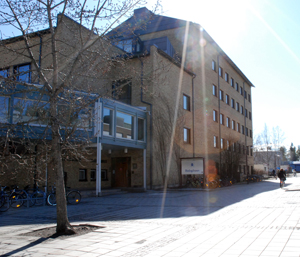Umeå
Umeå

The house was remodeled in 2019
Solar cells:
There are solar cells installed on the roof.
Error report:
Is there something wrong with your house? Report a problem on our website. Please include your room number when reporting a problem. The room number is listed on the doorpost.
In case of emergency problems outside of regular working hours (Monday-Friday, 7:30 a.m.-4:00 p.m.), you can call the emergency number 070-510 10 02.
Locking:
The building is equipped with a time-controlled central locking system. Outside of regular working hours, a pass card with a code is required for access.
When exiting through locked doors, press the button with the key symbol located next to the door. Also make sure the door locks.
There are separate containers for waste sorting in the building's garbage room/environment room. Akademiska Hus is responsible for emptying the garbage room. The tenant is responsible for removing bulky waste, pallets and larger packaging.
The following sorting:
- Paper
- Corrugated cardboard/Cardboard
- Colored and uncolored glass
- Metal
- Plastic packaging, LDPE
- Food waste
-Mixed waste
Recycled paper is sorted, handled and paid for directly by each tenant within the tenant's premises.
Waste such as chemical and biological waste is sorted, handled and paid for directly by each tenant within the premises.
Generally
Entrance and exterior lighting is switched on at dusk and switched off at dawn. Some led lighting is always on.
Lighting is switched on via a motion sensor in the corridor. To reduce energy consumption, the lighting is automatically switched off when no one is present. Remember that lighting and computers are switched off after the end of the working day. An office room corresponds to a consumption of approximately 1000 kWh/year.
Force
The electrical installations are made with a so-called 5-wire system, which minimizes the electric and magnetic fields. Interventions may not be carried out in the facility.
If changes are needed in the facility, contact Akademiska Hus.
Fire
Fire protection work is carried out on an ongoing basis. Generally, the landlord is responsible for fire protection outside the premises and the tenant for fire protection inside the premises. This is regulated in the lease agreement.
It is important not to store, place or leave anything in the stairwell or in public areas that could pose a fire risk, make it difficult to access and clean, or be disruptive to the well-being of the occupants.
Evacuation takes place via the respective stairwell. Each tenant is responsible for ensuring that there is an updated evacuation plan.
The building is equipped with an evacuation alarm in the event of a fire. In the event of smoke, smoke detectors trigger an evacuation alarm throughout the building and a signal to evacuate is given via a doorbell. If a fire is detected, call 112, as the evacuation alarm is not directly forwarded to the Rescue Services. Try to limit the fire source by closing windows and doors.
You can manually trigger the alarm yourself using push buttons in escape routes.
Detailed information about the building regarding fire cells, evacuation/assembly points, security alarms RWC, ventilation & gas alarms is formulated and described in the rental agreement. Contact your contact person at Akademiska Hus or customer service if you have any questions.
Personal and elevator alarms
It is possible to send an emergency signal from elevators. When the push button is held down for more than 15 seconds, a signal sounds outside the door and an alarm is sent to Akademiska Hus. After regular working hours, the alarm is sent to on-call staff or security guards.
Alarms from elevators are reset by operating personnel.
Car parking
Parking spaces intended for vehicles with a handicap permit can be found close to the main entrance. Please see Campus map .
Entrances and lifts
The entrances are accessible and all floors can be reached via lift.
RWC
Toilets adapted for the disabled are available on each floor. At the RWC there are security alarms with red push buttons labeled "emergency signal". Alarms are reset inside each room by pressing the reset button.
Generally
The ventilation system in the lab normally runs 24/7.
Classrooms and group rooms
Rooms with large variations in occupancy are equipped with demand-controlled ventilation.
Fume cupboard
Fume cupboards are equipped with automatic controls that keep the air velocity in the fume cupboard opening constant. If the door is opened too far, an optical and acoustic alarm is given.
HEAT
The house has a so-called water-based heating system for heating elements on the exterior walls.
The heat is controlled by the outdoor temperature and room temperature. This means that the heat on the element varies with the outdoor temperature and the temperature in the room.
Cold
Some rooms are cooled with fan air coolers, others with cooled ventilation.
Environmental construction
The Biology House met the requirements for Miljöbyggnad level Silver during renovation in 2017.
Miljöbyggnad is a certification system for creating environmentally sustainable buildings. It is based on Swedish building and authority regulations and Swedish building practice. Miljöbyggnad is a receipt for important qualities of a building in terms of energy, indoor environment and materials and is used for newly produced and existing buildings regardless of size. In Miljöbyggnad, a building can achieve a bronze, silver or gold rating. Behind the certification is the non-profit association Sweden Green Building Council (SGBC).